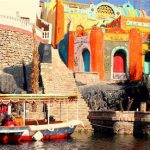Famous Landmarks in Egypt You Should Visit 2022
We’re going to know Famous Landmarks in Egypt You Should Visit in detail through this blog post from the FTS press.
Whenever it comes to journeys, one main factor which is always regarded is the cost. Traveling to Egypt is regarded to be very cost-effective, guess it depends on where you are having to travel from.
It is inexpensive even though, once all costs are taken into account, trips to Egypt are of excellent value because you can pack a lot in a small amount of time. There are several lavish choices available if you have a massive budget.
Egypt, an African country with links to the Mideast, is a residence of ancient Pharaohs, dazzling statues, as well as Famous Landmarks in Egypt You Should Visit.
Look here; Outdoor Activities to Do from Sharm El Sheikh 2022
Famous Landmarks in Egypt You Should Visit
The Great Sphinx of Giza
The Sphinx of Giza stands directly at the front of the Giza pyramids. The Giza Sphinx, standing 240 feet (73 meters) tall and 66 feet (20 meters) long, is not just one of the biggest and biggest Egyptian landmarks, and also one of the biggest in the world.
The sphinx was indeed a divine defender in Egyptian Civilization, and this is thought that the wonderful sphinx of Giza was built to protect the graves of the ancient Egyptians.
The sphinx was built in 2603 BC by Pharaoh Khafre, and it also does believe that the sphinx’s face and head depict an existing monument of Khafre discovered in the Temple Complex.
The Valley of the Kings
The Valley of the Kings one of Famous Landmarks in Egypt You Should Visit, located on the west bank of the Nile, is one of Egypt’s loveliest Monuments and Tourist Destinations.
This valley has become the burial place for the majority of the pharaohs, and also queens and princelings during the New Kingdom, and is made up of two valleys, the East or Valley of the Queens, in which moreover 60 graves have indeed been discovered.
Even though the graves were dug up in the sandstone of the valley hillsides for security purposes, defacement, and also to prevent unnecessary theft with their most valuable items, when they were found, they unearthed that had been pillaged.
Mosque of Muhammad Ali
While the Muhammad Ali Mosque isn’t culturally important, it is one of the most popular Islamic masjids for tourists to visit.
The Muhammad Ali Masjid in Cairo, Egypt, inside the Castle. By the use of opalescent rocks in its building projects, the masjid is commonly known as the Alabaster Masjid.
Look here; Sound and light show in Egypt
Hatshepsut’s Monastery and the Memnon Colossi
On the day of the Valley of the Kings trip, it is also advised to visit the Temple of Hatshepsut, one of Egypt’s greatest remarkable temples, and also halt at the front of the trying to impose Colossi of Memnon.
The Temple of Hatshepsut is distinctive in Egypt not only because of its layout, but because it also is devoted to no other female pharaoh, Queen Hatshepsut. It was constructed by the architect Senemut and also has a portion unearthed in the stone as well as an outer portion to 3 verandas that distinguishes this from the remainder of the country’s monuments. The provisions in the monastery depict the queen’s life.
Khan el-Khalili
It is practically impossible to visit Cairo without stopping at the Khan el-Khalili. Khan el-Khalili is a famous bazaar in the heart of Islamic Cairo that dates back to the 14th century.
The bazaar maintains a strong medieval feel and transports you back through time. The main draw here is the numerous stalls selling everything from memorabilia to style help, antique furniture, and spices.
If you’re going to look for something truly unique to recollect your journey by or to give to family and friends, the bazaar is the location to go.
Khan El-Khalili also has several historic and cultural sites, so it’s no shock that it attracts so very many tourists.
Karnak, one of Egypt’s most beautiful monuments
Karnak is a group of temples situated in Thebes, the area that was the headquarters of ancient Egypt for further than 1000 years, where for 2000 years and over 30 pharaohs competed and built the best temples and monuments in honor of the lord god Amun.
This canopy, made up of temples, obelisks, statues, as well as a huge sacrosanct lake, is the country’s second-busiest site after the pyramids, so it is also one of the most important cities to visit in Egypt.
The Great Hypostyle Hall, with those massive columns protected in exceptional exemptions as well as hieroglyphs, stands out amongst the structures, as does the Option of the Sphinxes.
The Monastery of St. Catherine
The Sacred Monastery of the God-Trodden Mount Sinai, also known as St. Catherine’s Monastery, is among the world’s oldest monastics but is still in usage presently. The burning bush described in the Old Testament of the Bible is said to be ensconced in the convent.
Since its building projects in the mid-500s AD, the monastery has indeed been home to several monks who have used Mount Sinai as a safeguard from the outside globe.
The Chapel of the Burning Bush is located within St Catherine’s Monastery, which should come as a shock. It is a tiny chamber located behind the altar, and it is frequently closed to traffic.
Kom Ombo Temple
The Temple of Kom Ombo, situated on the Nile’s banks approximately 50 kilometers from Aswan, was the 2nd temple we frequented during our Nile cruise, following the Temple of Philae. This temple, constructed by Ramses II, is unique in that it has symmetrical components, one dedicated to the god Sobek and the other to the god Haroeris.
Sobek was a god with a crocodile head and a physical figure, whereas Horus had a falcon’s head. Within the temple, there is a crocodile mummy, then on the outside, there are reliefs of surgical tools from the time.
Look here; Sharm El Sheikh’s ‘Al Sahaba Mosque 2022
Seti I Temple
Seti I is regarded as one of the less famous pharaohs of ancient Egypt’s Kingdom era. One shocking revelation is that his son Ramesses II ended up going on to become one of Egypt’s best-known pharaohs.
Although he is not one of Egypt’s most renowned pharaohs, his temple became one of the country’s best-known.
The Luxor Temple, constructed in 1279 BC, is a sandstone L-shaped framework rather than the pretty standard rectangle. Numerous visitors to Egypt assert that the temple is among the most remarkable religious buildings in the world.
Royal Gardens and Montaza Palace
Khedive Abbas II constructed the Montaza Palace as well as Royal Gardens at the turn of the twentieth century. Khedive was a relative of Egypt’s leader at the time, King Farouk.
The palace combines Turkish and Florentine styles of architecture to create a stunning European-style framework. It is located in Alexandria, near the coast, and is a short walk from the beach.
The Montaza Palace intricate includes a large museum as well as staggeringly beautiful royal gardens overlooking the Mediterranean. The gardens on their cover approximately 3,000 square meters and therefore are packed with meticulously manicured grass, tree branches, and plants.
Nasser Lake
Lake Nasser, the nation’s biggest manmade lake, was created in the mid-twentieth century to thwart recurring flooding induced by the Nile. It is another one of Egypt’s jewels.
A cruise on this lake, encircled by desert as well as home to the last Nile crocodiles, is worthwhile to appreciate a wonderful beautiful sunset, attend a Nubian village, and some of them around it shrines like Derr, Kalabsha, Kertassi, Amada, and Dakka.
Each of these cruise ships concludes at one of Old Egypt’s greatest stunning landmarks, the magnificent Abu Simbel.
Serapeum and Pompey’s Pillar
Pompey’s Pillar is the biggest Roman pillar discovered outside Greece, with a separate column. The pillar is on a steep hillside in Alexandria, Egypt.
Despite its name, the Pompey pillar has had no connection to General Gaius Pompey. The pillar stands 67 feet tall and has a Grote of about 8 feet. This was constructed in 298 AD in honor of Emperor Constantine, a Roman emperor.
Notwithstanding the being constructed for Diocletian, numerous warriors did believe that throughout the Middle Ages, the ashes of the Roman general Pompey were managed to keep in a pot on top of the column. Presently, the pillar provides a memorial to the location of the Temple of Serapeum.
The Horus Temple
The Temple of Horus, or Edfu, is Egypt’s second-biggest monastery after Karnak and among the most beautiful places to visit. Building on the Nile river in Edfu began during the rule of Ptolemy III in honor of the god Horus. The temple was built underground in the desert for centuries till it was found by the French Egyptologist Auguste Mariette.
Because of its buried location, it is one of the finest temples, with splendid statues and exemptions, and this is a popular stop for Nile cruises.
Ibn Tulun Mosque
There are numerous modern wall mount mosques in Cairo, but this masjid is among the most well but a must-see. The Ibn Tulun Mosque is the largest mosque in Egypt and the whole African continent. It also occurs to be Cairo’s largest mosque.
Whereas the mosque’s layout is simple, it is a lovely and soothing destination to vacation. If you are a practicing Muslim, you could also pray there because it is still a fully operational mosque.
In closing
We discovered a lot of Famous Landmarks in Egypt You Should Visit in the previous points, and we hope you like it too much mate.







